Experimental and Numerical Investigation of Static and Dynamic Characteristics of Bio-Oils and SAE40 in Fluid Film Journal Bearing
Abstract
1. Introduction
2. Theoretical Background
2.1. Static Performance Evaluation
2.2. Dynamic Performance Evaluation
3. Materials and Methods
3.1. Geometrical Model
3.2. Dynamic Viscosity Measurement
3.3. Computational Method
3.4. Mesh Refinement
4. Results and Discussion
4.1. Effect of Temperature on Dynamic Viscosity
4.2. Effect of Eccentricity Ratio ε on Stiffness K and Damping C Coefficients
4.3. Numerical Analysis
5. Conclusions
- ◦
- The dynamic viscosity drop is much less for bio-oils compared to SAE40. The stable behavior of bio-oils against the increasing temperature makes them suitable for high-temperature applications in journal bearings.
- ◦
- At 40 °C, the hydrodynamic pressure for SAE40 is observed to be 2.29, 2.39, and 3.01 times greater than those of rapeseed, palm olein, and soybean oil, respectively. Hence, the load-carrying capacity of oil film for SAE40 is also higher as the viscosity is higher compared to bio-oils.
- ◦
- By contrast, at 125 °C, the hydrodynamic pressure for SAE40 is observed to be 8% and 4.3% less than those of rapeseed and palm olein, respectively, but 14% greater than that of soybean oil. This decrease in hydrodynamic pressure causes the decline in load-carrying capacity of oil film for SAE40 compared to bio-oils.
- ◦
- Stiffness and damping coefficients are also investigated for different eccentricity ratios. Depending on the operating parameters (load, rotational speed, and viscosity), the value of eccentricity ratio can be calculated. The eccentricity ratio is important in evaluating the dynamic characteristics (stiffness and damping).
Author Contributions
Funding
Institutional Review Board Statement
Informed Consent Statement
Data Availability Statement
Acknowledgments
Conflicts of Interest
Nomenclature
| h | oil film thickness |
| C | radial clearance |
| N | rotational speed |
| D | diameter of bearing |
| L | length of bearing |
| P | pressure |
| U | velocity of fluid |
| e | eccentricity |
| ϕ | attitude angle |
| ε | eccentricity ratio |
| Kxx, Kyy | dimensionless direct stiffness |
| Kxy, Kyx | dimensionless cross-coupled stiffness |
| Cxx, Cyy | dimensionless direct stiffness |
| Cxy, Cyx | dimensionless cross-coupled stiffness |
References
- San Andrés, L. Hydrodynamic Fluid Film Bearings and Their Effect on the Stability of Rotating Machinery. In Design and Analysis of High Speed Pumps; Educational Notes RTO-EN-AVT-143, Paper 10; RTO: Neuilly-sur-Seine, France, 2006; pp. 10-1–10-36. [Google Scholar]
- Gong, R.Z.; Li, D.Y.; Wang, H.J.; Han, L.; Qin, D.Q. Analytical solution of Reynolds equation under dynamic conditions. Proc. Inst. Mech. Eng. Part J J. Eng. Tribol. 2016, 230, 416–427. [Google Scholar] [CrossRef]
- Jamalabadi, M.Y.A. Effects of Nanoparticle Enhanced Lubricant Films in Dynamic Properties of Plain Journal Bearings at High Reynolds Numbers. Int. J. Eng. Technol. 2017, 13, 1–23. [Google Scholar] [CrossRef]
- Nikolic, N.; Antonic, Z.; Doric, J.; Ruzic, D.; Galambos, S.; Jocanovic, M.; Karanovic, V. An analytical method for the determination of temperature distribution in short journal bearing oil film. Symmetry 2020, 12, 539. [Google Scholar] [CrossRef]
- Sadiq, M.I.; Ghopa, W.A.W.; Nuawi, M.Z.; Rasani, M.R.M.; Imran, T. Effect of Bio Lubricants on the Dynamic Performance of Rotor Bearing System: A Mathematical Model. In Structural Integrity Cases in Mechanical and Civil Engineering; Abdullah, S., Karam Singh, S.S., Md Nor, N., Eds.; Springer International Publishing: Cham, Switzerland, 2022; pp. 195–207. [Google Scholar]
- Wang, K.; Wu, J.; Zhao, G. Numerical analysis of sliding bearing dynamic characteristics based on Numerical analysis of sliding bearing dynamic characteristics based on CFD. J. Phys. Conf. Ser. 2017, 916, 012025. [Google Scholar] [CrossRef]
- Tauviqirrahman, M.; Jamari, J.; Bayuseno, A.P. A comparative study of finite journal bearing in laminar and turbulent regimes using cfd (computational fluid dynamic). MATEC Web Conf. 2016, 4001, 10–13. [Google Scholar]
- Hosain, M.L.; Fdhila, R.B. Literature Review of Accelerated CFD Simulation Methods towards Online Application. Energy Procedia 2015, 75, 3307–3314. [Google Scholar] [CrossRef]
- Concli, F.; Gorla, C. Windage, churning and pocketing power losses of gears: Different modeling approaches for different goals. Forsch. Ing. 2016, 80, 85–99. [Google Scholar] [CrossRef]
- Hanoca, P.; Ramakrishna, H. V To Investigate the Effect of Oil Film Thickness at the Entrance of the Infinitely Long Slider Bearing Using CFD Analysis. Procedia Eng. 2015, 127, 447–454. [Google Scholar] [CrossRef][Green Version]
- Chauhan, A.; Singla, A.; Panwar, N.; Jindal, P. CFD Based Thermo-Hydrodynamic Analysis of Circular Journal Bearing. Int. J. Adv. Mech. Eng. 2014, 4, 475–482. [Google Scholar]
- Manshoor, B.; Jaat, M.; Izzuddin, Z.; Amir, K. CFD Analysis of Thin Film Lubricated Journal Bearing. Procedia Eng. 2013, 68, 56–62. [Google Scholar] [CrossRef]
- Gertzos, K.P.; Nikolakopoulos, P.G.; Papadopoulos, C.A.Ã. CFD analysis of journal bearing hydrodynamic lubrication by Bingham lubricant. Tribol. Int. 2008, 41, 1190–1204. [Google Scholar] [CrossRef]
- Wang, C.; Morvan, H.P.; Hibberd, S.; Cliffe, K.A.; Anderson, A.; Jacobs, A. Specifying and Benchmarking a Thin Film Model for Oil Systems Applications in ANSYS Fluent. In Proceedings of the ASME Turbo Expo 2012: Turbine Technical Conference and Exposition, Copenhagen, Denmark, 11–15 June 2012; pp. 229–234. [Google Scholar]
- Ghani, J.A.; Mohd Nasir, F.F.; Rahman, H.A.; Hakim Wan Zamri, W.F.; Kasim, M.S.; Muhamad, S.S. Computational fluid dynamic analysis on tribological performance under hydrodynamic lubrication of dimple textured surface produced using turning process. Wear 2021, 477, 203898. [Google Scholar] [CrossRef]
- Mu, A.; Abdul, I.; Tantiyani, N.; Ali, B. Computational Fluid Dynamics Simulation of Fluidized Bed Dryer for Sago Pith Waste Drying Process Computational Fluid Dynamics Simulation of Fluidized Bed Dryer for Sago Pith Waste Drying Process. J. Kejuruter. 2021, 33, 239–248. [Google Scholar] [CrossRef]
- Ng, J. Computational fluid dynamics simulation on the heat sink performance of a graphics processing unit thermal management. J. Kejuruter. 2019, 31, 139–147. [Google Scholar] [CrossRef]
- Najar, F.A.; Harmain, G.A. Numerical Investigation of Pressure Profile in Hydrodynamic Lubrication Thrust Bearing. Int. Sch. Res. Not. 2014, 2014, 1–8. [Google Scholar] [CrossRef][Green Version]
- Nowak, P.; Kucharska, K.; Kamiński, M. Ecological and Health Effects of Lubricant Oils Emitted into the Environment. Int. J. Environ. Res. Public Health 2019, 16, 3002. [Google Scholar] [CrossRef]
- Syahir, A.Z.; Zulkifli, N.W.M.; Masjuki, H.H.; Kalam, M.A.; Alabdulkarem, A.; Gulzar, M.; Khuong, L.S.; Harith, M.H. A review on bio-based lubricants and their applications. J. Clean. Prod. 2017, 168, 997–1016. [Google Scholar] [CrossRef]
- Trzepieciński, T. Tribological performance of environmentally friendly bio-degradable lubricants based on a combination of boric acid and bio-based oils. Materials 2020, 13, 3892. [Google Scholar] [CrossRef]
- Li, L.; Liu, Z.; Wang, C.; Xie, Y. Influence of temperature effect on the static and dynamic performance of gas-lubricatedmicrobearings. Micromachines 2020, 11, 716. [Google Scholar] [CrossRef]
- Sun, D.; Li, S.; Fei, C.; Ai, Y.; Liem, R.P. Investigation of the effect of cavitation and journal whirl on static and dynamic characteristics of journal bearing. J. Mech. Sci. Technol. 2019, 33, 77–86. [Google Scholar] [CrossRef]
- Hmoad, N. Effect of Using the Biolubricant Oil on the Dynamic Performance of Journal Bearings. Int. J. Mech. Mechatron. Eng. 2020, 20, 77–84. [Google Scholar]
- He, M.; Cloud, C.H.; Byrne, J.M.; Vázquez, J.A. Fundamentals of Fluid Film Journal Bearing Operation and Modeling. In Proceedings of the 34th Turbomachinery Conference 2005, Houston, TX, USA, 12–15 December 2005. [Google Scholar]
- Wan Nik, W.B.; Ani, F.N.; Masjuki, H.H.; Eng Giap, S.G. Rheology of bio-edible oils according to several rheological models and its potential as hydraulic fluid. Ind. Crops Prod. 2005, 22, 249–255. [Google Scholar] [CrossRef]
- Wróblewski, P. Analysis of Torque Waveforms in Two-Cylinder Engines for Ultralight Aircraft Propulsion Operating on 0W-8 and 0W-16 Oils at High Thermal Loads Using the Diamond-Like Carbon Composite Coating. SAE Int. J. Engines 2021, 15, 8–11. [Google Scholar] [CrossRef]
- Sadiq, M.I.; Ghopa, W.A.; Nuawi, M.Z.; Rasani, M.R. An Experimental Investigation of Static Properties of Bio-Oils. Materials 2022, 15, 2247. [Google Scholar] [CrossRef]
- Hoang, A.T.; Pham, M.T. Influences of heating temperatures on physical properties, spray characteristics of bio-oils and fuel supply system of a conventional diesel engine. Int. J. Adv. Sci. Eng. Inf. Technol. 2018, 8, 2231–2240. [Google Scholar] [CrossRef]
- Lee, C.W. Vibration Analysis of Rotors; Springer: Berlin/Heidelberg, Germany, 1994; Volume 208, ISBN 9789048142804. [Google Scholar]
- Hekmat, M.H.; Biukpour, G.A. Numerical study of the oil whirl phenomenon in a hydrodynamic journal bearing. J. Braz. Soc. Mech. Sci. Eng. 2019, 41, 218. [Google Scholar] [CrossRef]
- Du, F.; Chen, C.; Zhang, K. Fluid Characteristics Analysis of the Lubricating Oil Film and the Wear Experiment Investigation of the Sliding Bearing. Coatings 2022, 12, 67. [Google Scholar] [CrossRef]
- Encinar, J.M.; Nogales-Delgado, S.; Sánchez, N.; González, J.F. Biolubricants from rapeseed and castor oil transesterification by using titanium isopropoxide as a catalyst: Production and characterization. Catalysts 2020, 10, 366. [Google Scholar] [CrossRef]
- Nuawi, M.Z. Mesokurtosis Zonal Nonparametric signal analysis for dynamic characterisation of metallic material. J. Kejuruter. 2012, 24, 21–27. [Google Scholar]
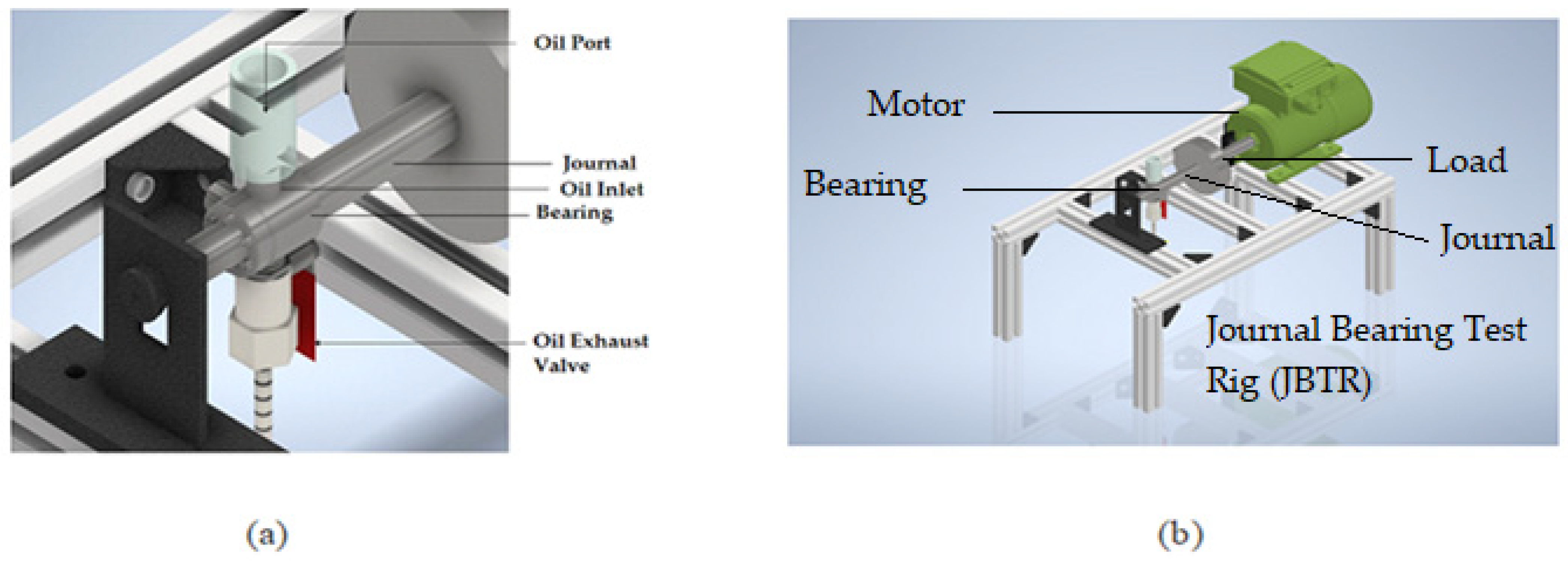
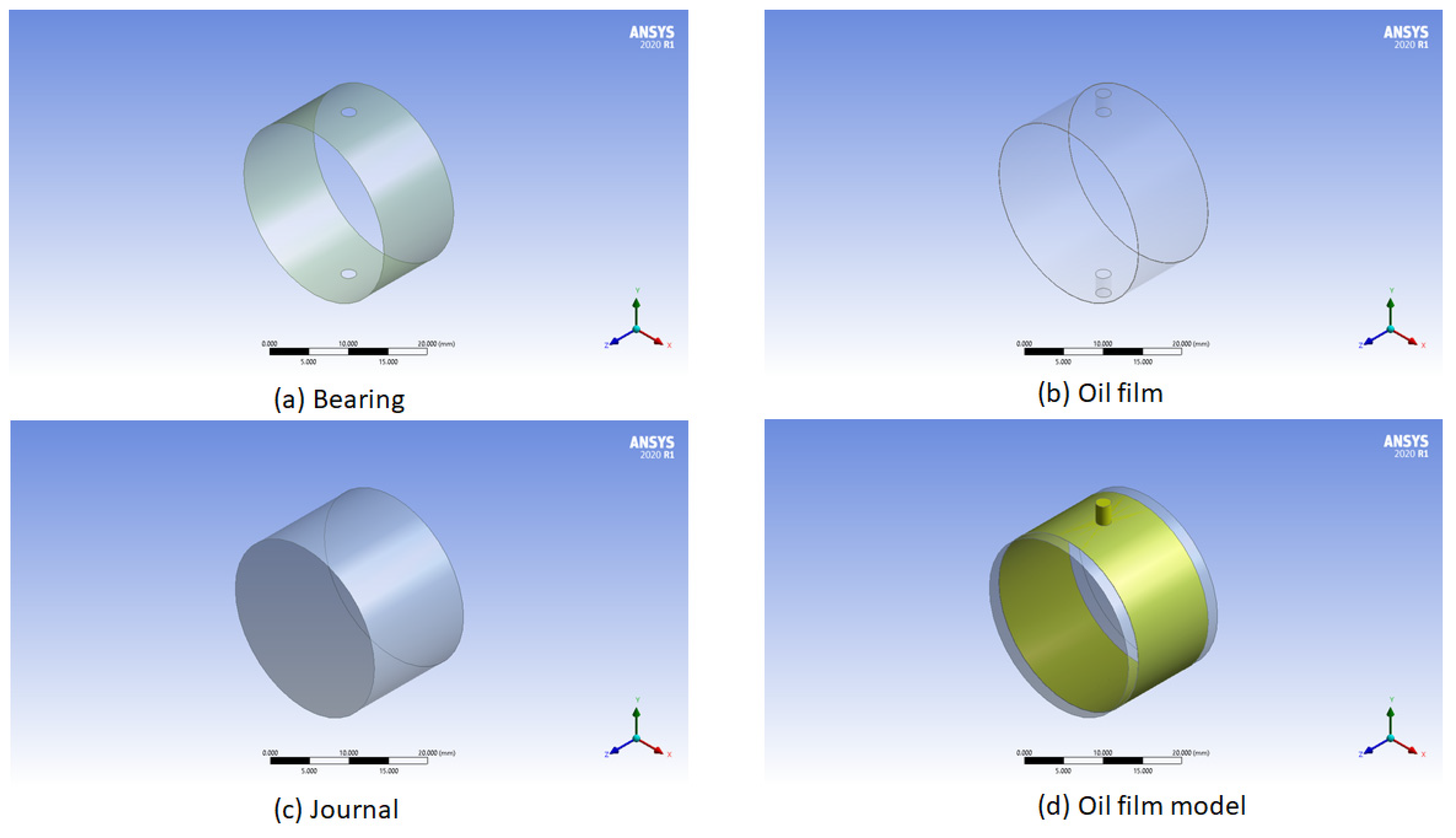

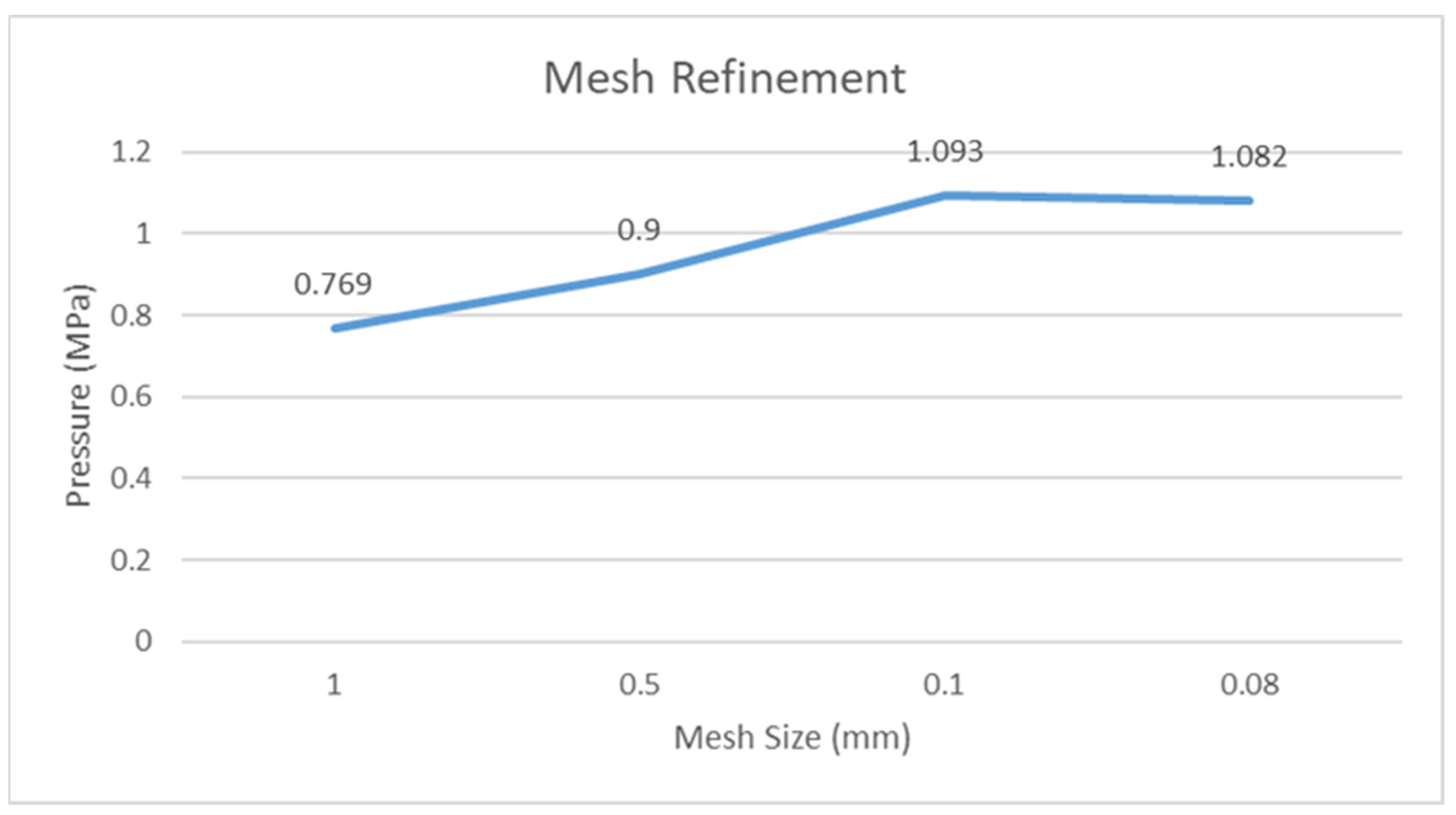
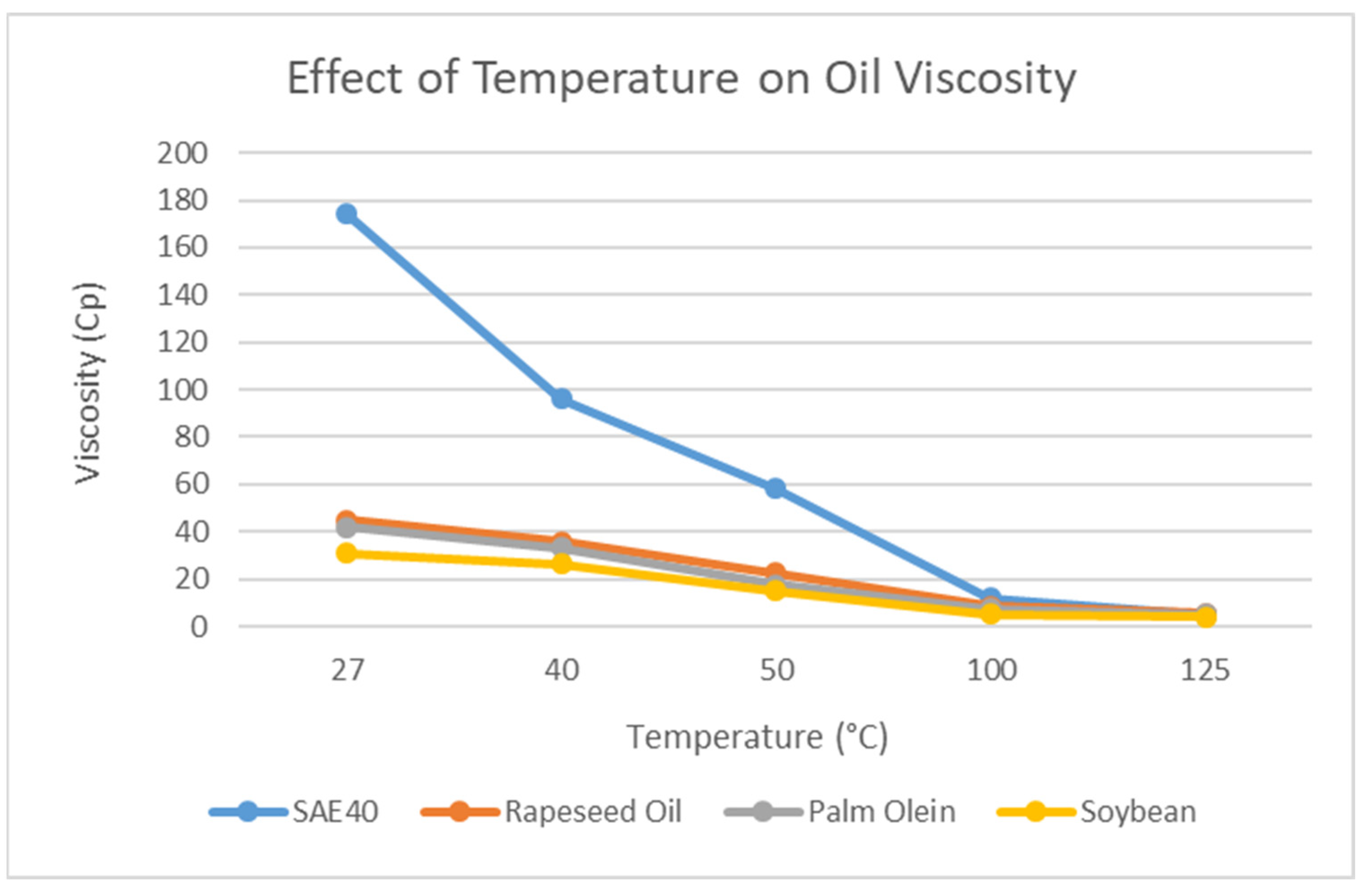
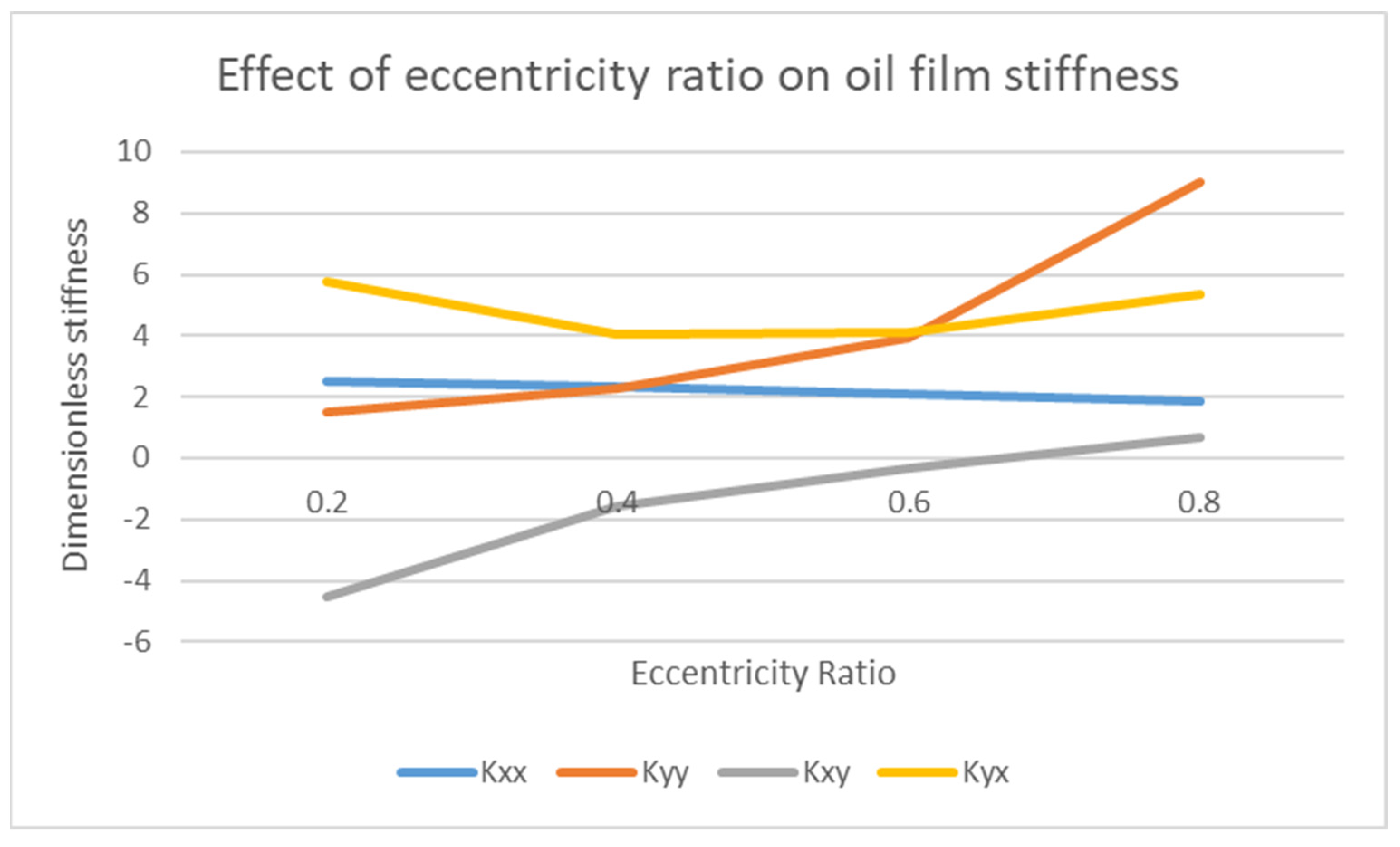

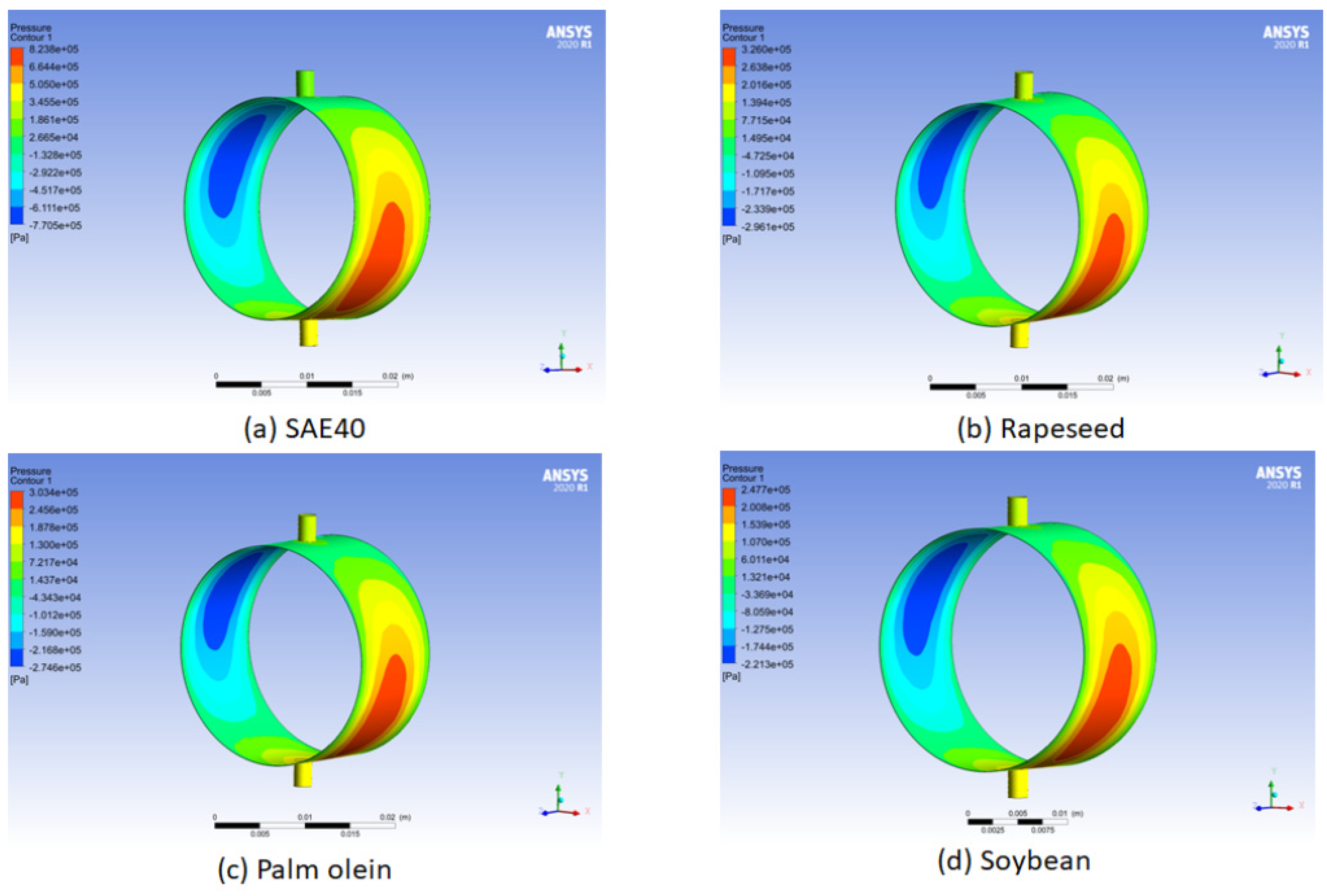
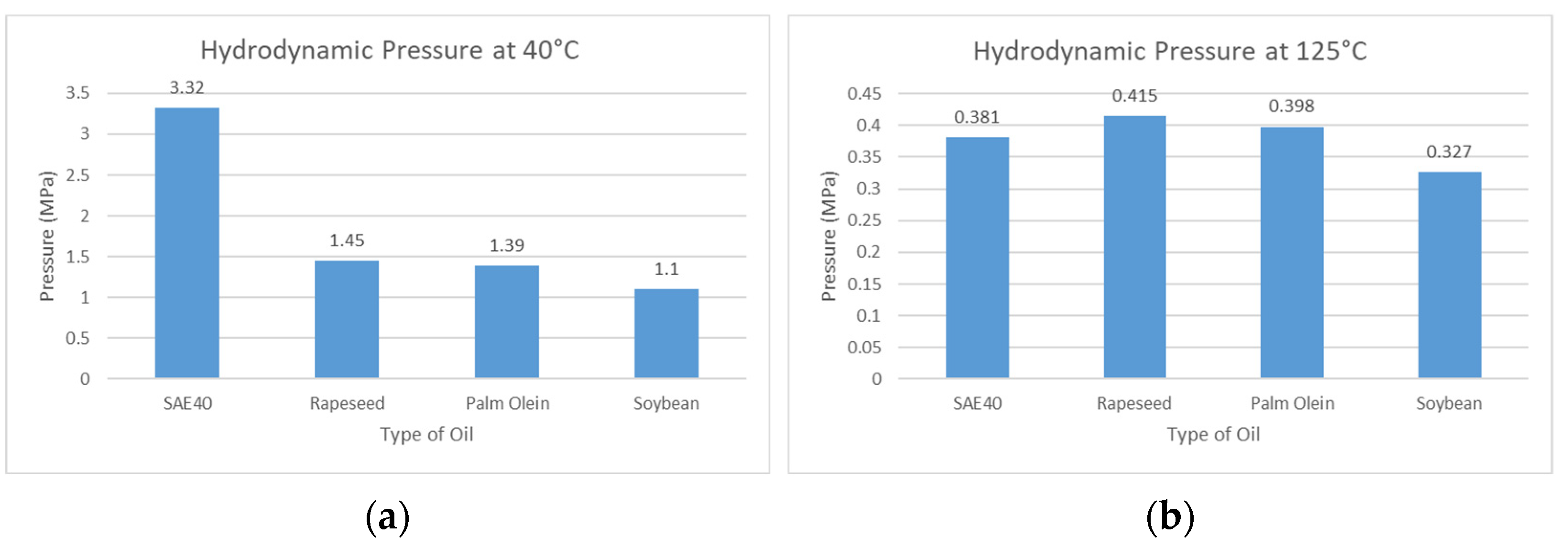

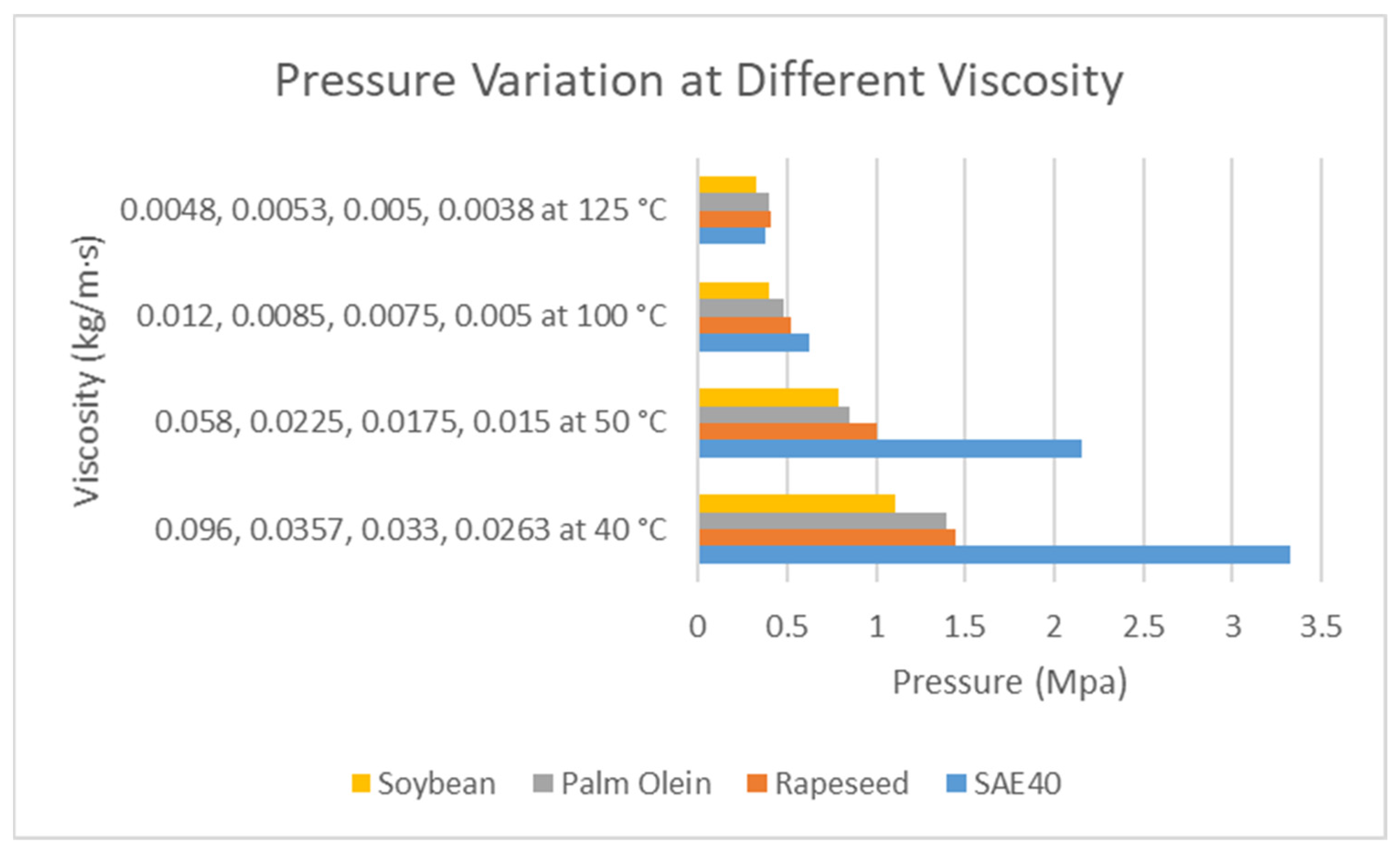
| No | Description | Specification |
|---|---|---|
| 1 | L, bearing length | 12.5 mm |
| 2 | D, inner diameter for plain bearing | 25.14 mm |
| 3 | d, shaft diameter | 25 mm |
| 4 | Weight of journal | 9 N |
| 5 | W, Weight of load | 25 N |
| 6 | CT, total clearance | 0.14 mm |
| 7 | C, radial clearance | 0.07 mm |
| 8 | ε, Eccentricity ratio | 0.2–0.8 |
| 9 | L/d ratio (short bearing assumption) | 0.5 |
| 10 | Operating speed | 1000~3000 rpm |
| Properties | SAE40 | Palm Olein | Rapeseed | Soya Bean |
|---|---|---|---|---|
| Flash point (°C) | 235 | 324 | 326 | 330 |
| Specific heat, Cp (kJ/kg·C) | 2.53 | 1.9 | 1.96 | 1.88 |
| Thermal conductivity (W/m·C) | 0.145 | 0.172 | 0.168 | 0.185 |
| Density at 15 °C (g/cm3) | 0.890 | 0.912 | 0.915 | 0.924 |
Publisher’s Note: MDPI stays neutral with regard to jurisdictional claims in published maps and institutional affiliations. |
© 2022 by the authors. Licensee MDPI, Basel, Switzerland. This article is an open access article distributed under the terms and conditions of the Creative Commons Attribution (CC BY) license (https://creativecommons.org/licenses/by/4.0/).
Share and Cite
Sadiq, M.I.; Ghopa, W.A.W.; Nuawi, M.Z.; Rasani, M.R.; Mohd Sabri, M.A. Experimental and Numerical Investigation of Static and Dynamic Characteristics of Bio-Oils and SAE40 in Fluid Film Journal Bearing. Materials 2022, 15, 3595. https://doi.org/10.3390/ma15103595
Sadiq MI, Ghopa WAW, Nuawi MZ, Rasani MR, Mohd Sabri MA. Experimental and Numerical Investigation of Static and Dynamic Characteristics of Bio-Oils and SAE40 in Fluid Film Journal Bearing. Materials. 2022; 15(10):3595. https://doi.org/10.3390/ma15103595
Chicago/Turabian StyleSadiq, Muhammad Imran, Wan Aizon W. Ghopa, Mohd Zaki Nuawi, Mohammad Rasidi Rasani, and Mohd Anas Mohd Sabri. 2022. "Experimental and Numerical Investigation of Static and Dynamic Characteristics of Bio-Oils and SAE40 in Fluid Film Journal Bearing" Materials 15, no. 10: 3595. https://doi.org/10.3390/ma15103595
APA StyleSadiq, M. I., Ghopa, W. A. W., Nuawi, M. Z., Rasani, M. R., & Mohd Sabri, M. A. (2022). Experimental and Numerical Investigation of Static and Dynamic Characteristics of Bio-Oils and SAE40 in Fluid Film Journal Bearing. Materials, 15(10), 3595. https://doi.org/10.3390/ma15103595






